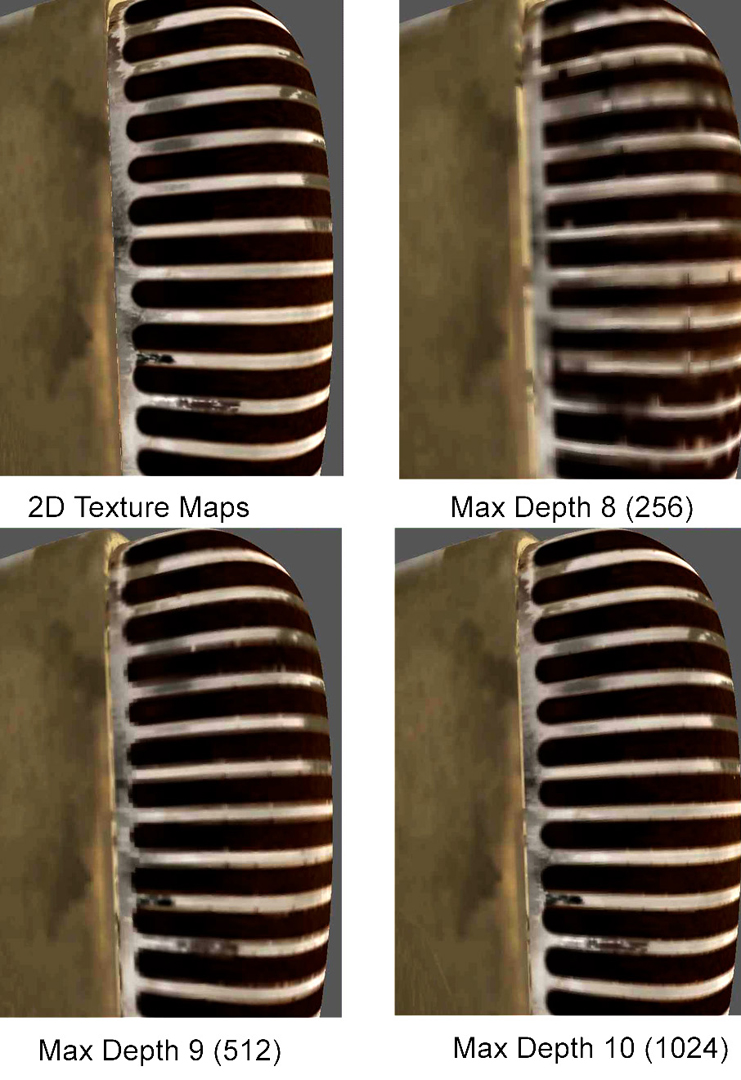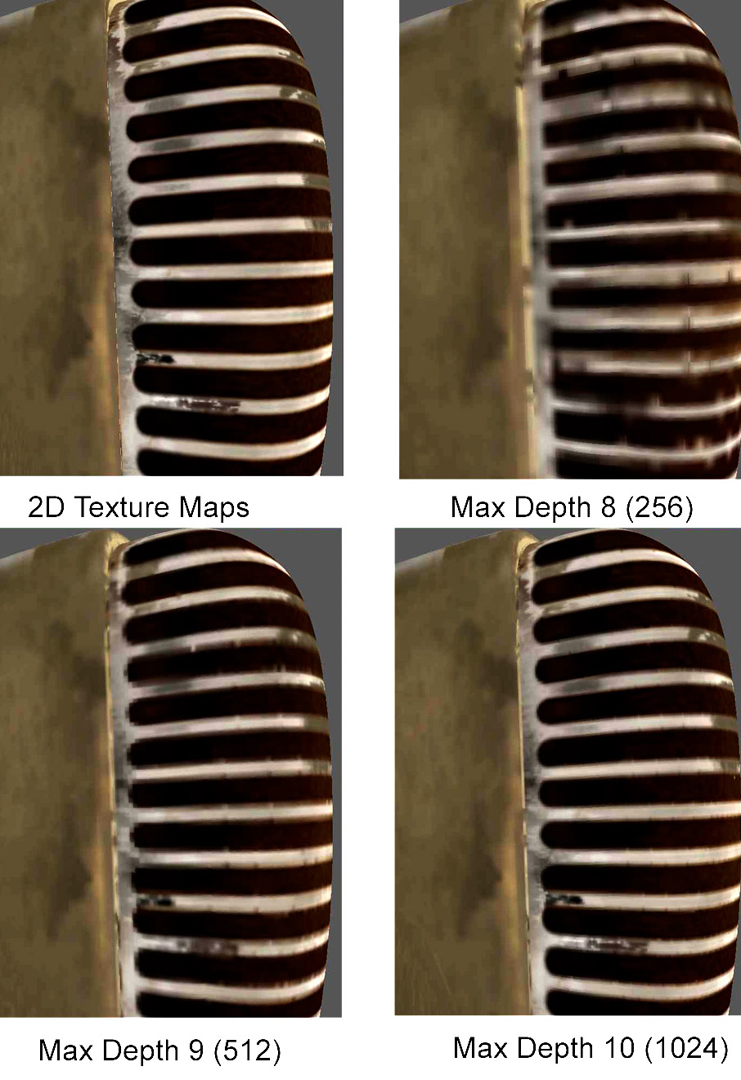“Octree textures”
Conference:
Type(s):
Title:
- Octree textures
Presenter(s)/Author(s):
Abstract:
Texturing using a set of two dimensional image maps is an established and widespread practice. However, it has many limitations. Parameterizing a model in texture space can be very difficult, particularly with representations such as implicit surfaces, subdivision surfaces, and very dense or detailed polygonal meshes. This paper proposes the use of a new kind of texture based on an octree, which needs no parameterization other than the surface itself, and yet has similar storage requirements to 2D maps. In addition, it offers adaptive detail, regular sampling over the surface, and continuity across surface boundaries. The paper addresses texture creation, painting, storage, processing, and rendering with octree textures.
References:
1. K. Akeley. Realityengine graphics. Proceedings of SIGGRAPH 93, 1993. Google Scholar
2. D. Berman, J. Bartell, and D. Salesin. Multiresolution painting and compositing. Proceedings of SIGGRAPH 94, 1994. Google Scholar
3. J. Bloomenthal. Polygonization of implicit surfaces. Proceedings of SIGGRAPH 88, 1988.Google Scholar
4. E. E. Catmull. A subdivision algorithm for computer display of curved surfaces. Master’s thesis, University of Utah, December 1974. Google Scholar
5. P. Cignoni, C. Montani, C. Rocchini, and R. Scopigno. A general method for preserving attribute values on simplified meshes. IEEE Visualization 1998 Proceedings, pages 59-66, 1998. Google Scholar
6. D. DeBry, J. Gibbs, D. Petty, and N. Robins. Painting and rendering textures on unparameterized models. Proceedings of SIGGRAPH 02, 2002. Google Scholar
7. R. Drebin, L. Carpenter, and P. Hanrahan. Volume rendering. Proceedings of SIGGRAPH 88, 1988. Google Scholar
8. S. F. Frisken, R. N. Perry, A. P. Rockwood, and T. R. Jones. Adaptively sampled distance fields: A general representation of shape for computer graphics. Proceedings of SIGGRAPH 00, 2000. Google Scholar
9. S. Gortler, R. Grzeszczuk, R. Szeliski, and M. Cohen. The lumigraph. Proceedings of SIGGRAPH 96, pages 43-54, 1996. Google Scholar
10. J. T. Kajiya and B. P. Von Herzen. Ray tracing volume densities. Proceedings of SIGGRAPH 84, 1984. Google Scholar
11. L. Kobbelt, M. Stamminger, and H. P. Seidel. Using subdivision on hierarchical data to reconstruct radiosity distribution. Proceedings of EUROGRAPHICS 97, 1997.Google Scholar
12. D. Laur and P. Hanrahan. Hierarchical splatting: A progressive refinement algorithm for volume rendering. Proceedings of SIGGRAPH 91, 1991. Google Scholar
13. D. Lischinski and A. Rappoport. Image-based rendering for non-diffuse synthetic scenes. Rendering Techniques 98, pages 165-174, 1998.Google Scholar
14. J Maillot, Y. Hussein, and A. Verroust. Interactive texture mapping. Proceedings of SIGGRAPH 93, 1993. Google Scholar
15. M. Maruya. Generating texture map from object-surface texture data. Proceedings of EUROGRAPHICS 95, pages 397-405, 1995.Google Scholar
16. D. R. Peachy. Solid texturing of complex surfaces. Proceedings of SIGGRAPH 85, 1985. Google Scholar
17. K. Perlin. An image synthesizer. Proceedings of SIGGRAPH 85, 1985. Google Scholar
18. H. Pfister, M. Zwicker, J. VanBaar, and M. Gross. Surfels:surface elements as rendering primitives. Proceedings of SIGGRAPH 00, 2000. Google Scholar
19. Dan Piponi and George Borshukov. Texture mapping of subdivision surfaces by model pelting and texture blending. Proceedings of SIGGRAPH 00, 2000. Google Scholar
20. P. Sander, X. Gu, S. Gortler, and H. Hoppe. Silhouette clipping. Proceedings of SIGGRAPH 00, pages 327-334, 2000. Google Scholar
21. P. Sander, J. Snyder, S. Gortler, and H. Hoppe. Texturing progressive meshes. Proceedings of SIGGRAPH 01, 2001. Google Scholar
22. M. Segal and K. Akeley. The opengl graphics system: A specification. http://www.opengl.org/Documentations/Specs.html, 1997.Google Scholar
23. M. Soucy, G. Godin, and M. Rioux. A texture mapping approach for the compression of colored 3d triangulations. The Visual Computer, pages 503-514, 1986.Google Scholar
24. M. Tamminen and H. Samet. Efficient octree conversion by connectivity labeling. Proceedings of SIGGRAPH 84, 1984. Google Scholar
25. G. Turk. Generating textures on arbitrary surfaces using reaction-diffusion. Proceedings of SIGGRAPH 91, 1991. Google Scholar
26. Li-Yi Wei and Marc Levoy. Texture synthesis over arbitrary manifold surfaces. Proceedings of SIGGRAPH 01, 2001. Google Scholar
27. L. Williams. Pyramidal parametrics. Proceedings of SIGGRAPH 83, 1983. Google Scholar





